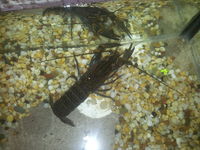Difference between revisions of "Cherax destructor"
From The Aquarium Wiki
m (Reverted edits by 163.232.200.107 (talk) to last revision by Catxx) |
(That’s a,,) |
||
| Line 1: | Line 1: | ||
| − | + | MISHYA HOLLINGWORTH | |
{{Fish Data | {{Fish Data | ||
|name = Common Yabby | |name = Common Yabby | ||
|image = Common_Yabby.jpg | |image = Common_Yabby.jpg | ||
| − | |caption = | + | |caption = Peanut |
| − | |species = | + | |species = Orange |
|difficulty = E | |difficulty = E | ||
|min_tank_size = 20 | |min_tank_size = 20 | ||
Latest revision as of 04:47, 9 June 2021
MISHYA HOLLINGWORTH
Orange
76 Litres (20 US G.)
10-16 cm (3.9-6.3")
Freshwater
7.0 - 10.5
20 -25 °C (68-77°F)
10-150 °d
1:1 M:F
3-12 years
This animal is available captive bred
Contents
Alternative names[edit]
- Western Blue Claw, crawchie, crawdad, craybob, freshwater yabby
'Note: The name "yabby" is ocassionaly used to refer to any freshwater crayfish species in Australia, such as the Blue Yabby; and the saltwater ghost shrimp found in mud flats and estuaries.'
Sexing[edit]
- The reproductive papillae of the male yabby are short projections found on the bases of the last pair of walking legs. The female has oval openings on the bases of the third-last pair of legs. Occasionally you may find individuals with a combination of male and female openings, but rather than being true hermaphrodites they usually prove to be of one functional sex. Breeding maturity is reached between 6 and 10 cm.
- In warm water a pair of yabbies will produce an average of 2-3 breedings per season and approximately 1,000 young per female per year.
Tank compatibility[edit]
- They are a bottom dweller and will eat anything they come across, as they are opportunistic eaters. It is not advisable to keep this species in the same aquarium as small or bottom-dwelling fish as these are easy prey at night time for this species. If they can catch passing fish they will also be eaten and they are often seen actively hunting nearby fish, with claws open. Ideally suited to a single species tank only. Plants will be uprooted & eaten. Sunken wood will also be consumed or moved.
Diet[edit]
- These Crayfish are nocturnal detritivores and omnivorous, and will act as a scavenger in the aquarium, eating any food that comes to rest on the bottom. Supplement their diet with a quality sinking sinking pellet and meaty food such as fish fillets.
Feeding regime[edit]
- Feed once a day - supplementing when necessary as the yabby grows larger. More active feeding will potentially discourage hunting. Note that yabbies will eat plants and wood.
Environment Specifics[edit]
- Occurs in much of south western Queensland, central and western New South Wales, the majority of Victoria and eastern parts of South Australia ranging from tropical to temperate climates. It is capable of living in most fresh water bodies and is found especially in lakes and dams, also frequenting rivers and temporary water.
- Plenty of cover should be included in the aquarium, including both rocks and plants (Although the plants will not last long as the yabby gets larger). After moulting the crayfish is vulnerable to attack and consumption by others.
- The yabby will shed its exoskeleton to grow, so be sure not to confuse this for a deceased yabby. Do not remove the discarded exoskeleton as the yabby may eat it to recycle the calcuim and other minerals.
- Able to survive in water temperatures between 1-35ºC, it will show the best growth in water temperatures between 20-25ºC. Temperatures below 16ºC the metabolism and feeding all but cease and the yabby may appear to be hibernating.
- Able also to tolerate a wide range of dissolved oxygen levels, turbidity and salinity. They can live satisfactorily in 75% sea-water solution (24,000 ppm).
Behaviour[edit]
- Yabbies are fast growing and territorial with their own species. They will learn to actively hunt most tankmates including fish, crustacea and snails.
- Below 10°C yabbies will not feed; and from 10–14°C they feed but without significant growth. Above this temperature there is noticeable growth, but the best growth occurs when water temperatures are between 22–28°C. It is possible for a yabby to grow from juvenile to over 15cm (5.9") in as little as 12 months.
- While they do not burrow much unless water quality is poor, they will dig out under rocks and enlarge holes where possible. A larger aquarium will be needed if housing more than one yabby, though housing multiple males together is not recommended. Provide at least 60 Litres (15.9US G.) per yabby and include plenty of cover including both rocks and plants. Fights are common, often resulting in loss of limbs, especially as the water gets warmer.
- Yabbies are an important dietary item for Australian native freshwater fish.
Identification[edit]
- Generally they are black, blue-black or dark brown in clear waters to light brown, green-brown or beige in turbid waters. Bright blue variants have been bred for aquarium use and generally command a higher price.
